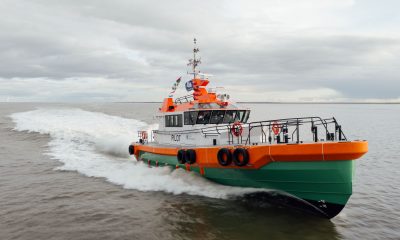News
A Pembrokeshire couple’s struggle with Lasting Power of Attorney application

IN LAWRENNY, Pembrokeshire a tale of love, resilience, and bureaucratic hurdles unfolded when Alan Woodhouse, 71, suffered a stroke earlier this year.
As his health began to decline, he found it increasingly challenging to manage his finances. To ease his burden, Alan and his devoted wife, Donna, 58, decided to apply for a lasting power of attorney (LPA), allowing Donna to take control of his financial affairs.
“I was more or less told that he wouldn’t be able to manage paying the bills,” said Donna, expressing her concern for her husband’s well-being.
An LPA is a legal arrangement that permits someone to act on your behalf if you can’t manage your finances or fear you won’t be able to do so in the future. The application must be approved by the Office of the Public Guardian (OPG), but time was of the essence for Donna and Alan.
With a sense of urgency, Donna filled out all the required forms from gov.uk and sent them off to the OPG in early April. However, the couple’s hopes were dashed two months later when they learned that their application had been rejected due to a minor issue with one of the dates beside Alan’s signature.
“There was a tiny line through the 0 in the date,” recounted Donna, visibly devastated by the rejection. “I thought it had all gone through. To my mind, it was silly.”
The rejection meant that Donna had to apply for another power of attorney, with the average registration process taking a staggering 20 weeks. The OPG offered a reduced fee of £41 if she resubmitted the application within three months, but the prolonged wait left Donna concerned that Alan’s health could worsen before the forms were approved.
Donna’s experience is not unique, as thousands of people across the UK face similar challenges with LPA applications. Financial and health LPAs have faced rejection at an alarming rate of 16.5% since 2018, according to data from the wealth manager Quilter.
In the past two financial years, the number of rejections has spiked, causing distress and uncertainty for many families. During the 2021-22 financial year, a staggering 31,254 LPAs were rejected, with the following year seeing only a slight dip to 29,124 rejections. These figures are significantly higher than in previous years, reflecting the growing concerns surrounding the LPA process.
Rosie Hooper from Quilter highlighted the difficulties applicants face, stating, “Navigating through the complexities of LPA applications can often feel like a difficult path.”
The primary reason for the high rejection rates lies in families’ lack of understanding of the legal requirements outlined in the Mental Health Capacity Act, according to Nicola Bushby from the law firm Boodle Hatfield. Many applicants inadvertently include instructions that violate the Act, leading to their forms being rejected.
Bushby emphasised the need for clearer guidance for families, suggesting that better alignment with the Mental Health Capacity Act could alleviate the issue. One common mistake involves the signing order, where improper sequencing invalidates the LPA.
Sarah Lockyer from the law firm Nockolds further highlighted potential pitfalls, noting that any mistakes on the form must be corrected in a specific manner, with initials from all involved parties to validate the changes. The use of Tipp-Ex is strictly prohibited, she warned.
In response to the rising concerns, the Ministry of Justice assured that plans to modernise and simplify the LPA process are underway, aiming for quicker and error-free applications, while strengthening fraud protection.
A Ministry of Justice spokesperson told The Pembrokeshire Herald: “If an application is started on our online LPA service, any issues will be highlighted so they can be rectified before the application is printed, signed and sent in to be registered.”
“Plans to modernise and simplify LPAs are going through Parliament — meaning the process will be quicker, with fewer errors and better protection from fraud.”
As families like Donna and Alan’s continue to navigate the intricate LPA landscape, it remains essential for individuals to seek expert advice and fully comprehend the intricacies of the process. With improvements on the horizon, hope shines through that the bureaucratic roadblocks will be cleared, allowing families to secure a lasting power of attorney with greater ease and confidence.
Adapted from an article originally appearing in The Times
Crime
Swansea man dies weeks after release from troubled HMP Parc: Investigation launched

A SWANSEA man has died just weeks after being released from HMP Parc, the Bridgend prison now at the centre of a national crisis over inmate deaths and post-release failures.
Darren Thomas, aged 52, died on 13 November 2025 — less than a month after leaving custody. The Prisons and Probation Ombudsman (PPO) has confirmed an independent investigation into his death, which is currently listed as “in progress”.
Born on 9 April 1973, Mr Thomas had been under post-release supervision following a period at HMP/YOI Parc, the G4S-run prison that recorded seventeen deaths in custody in 2024 — the highest in the UK.
His last known legal appearance was at Swansea Crown Court in October 2024, where he stood trial accused of making a threatening phone call and two counts of criminal damage. During the hearing, reported by The Pembrokeshire Herald at the time, the court heard he made threats during a heated call on 5 October 2023.
Mr Thomas denied the allegations but was found guilty on all counts. He was sentenced to a custodial term, which led to his imprisonment at HMP Parc.
Parc: A prison in breakdown
HMP Parc has faced sustained criticism throughout 2024 and 2025. A damning unannounced inspection in January found:
- Severe self-harm incidents up 190%
- Violence against staff up 109%
- Synthetic drugs “easily accessible” across wings
- Overcrowding at 108% capacity
In the first three months of 2024 alone, ten men died at Parc — part of a wider cluster of twenty PPO-investigated deaths since 2022. Six occurred within three weeks, all linked to synthetic drug use.
Leaked staff messages in 2025 exposed a culture of indifference, including one officer writing: “Let’s push him to go tomorrow so we can drop him.”
Six G4S employees have been arrested since 2023 in connection with alleged assaults and misconduct.
The danger after release
Deaths shortly after release from custody are a growing national concern. Ministry of Justice data shows 620 people died while under community supervision in 2024–2025, with 62 deaths occurring within 14 days of release.
Short sentences — common at Parc — leave little time for effective rehabilitation or release planning. Homelessness, loss of drug tolerance and untreated mental-health conditions create a high-risk environment for those newly released.
The PPO investigates all such deaths to determine whether prisons or probation failed in their duties. Reports often take 6–12 months and can lead to recommendations.
A system at breaking point
The crisis at Parc reflects wider failures across UK prisons and probation. A July 2025 House of Lords report described the service as “not fit for purpose”. More than 500 people die in custody annually, with campaigners warning that private prisons such as Parc prioritise cost-cutting over care.
The PPO investigation into the death of Darren Thomas continues.
Crime
Woman stabbed partner in Haverfordwest before handing herself in

A WOMAN who stabbed her partner during a drug-fuelled episode walked straight into Haverfordwest Police Station and told officers what she had done, Swansea Crown Court has heard.
Amy Woolston, 22, of Dartmouth Street in Milford Haven, arrived at the station at around 8:00pm on June 13 and said: “I stabbed my ex-partner earlier… he’s alright and he let me walk off,” prosecutor Tom Scapens told the court.
The pair had taken acid together earlier in the day, and Woolston claimed she believed she could feel “stab marks in her back” before the incident.
Police find victim with four wounds
Officers went to the victim’s home to check on him. He was not there at first, but returned shortly afterwards. He appeared sober and told police: “Just a couple of things,” before pointing to injuries on his back.
He had three stab or puncture wounds to his back and another to his bicep.
The victim said that when he arrived home from the shop, Woolston was acting “a bit shifty”. After asking if she was alright, she grabbed something from the windowsill — described as either a knife or a shard of glass — and stabbed him.
He told officers he had “had worse from her before”, did not support a prosecution, and refused to go to hospital.
Defendant has long history of violence
Woolston pleaded guilty to unlawful wounding. The court heard she had amassed 20 previous convictions from 10 court appearances, including assaults, battery, and offences against emergency workers.
Defending, Dyfed Thomas said Woolston had longstanding mental health problems and had been off medication prescribed for paranoid schizophrenia at the time.
“She’s had a difficult upbringing,” he added, saying she was remorseful and now compliant with treatment.
Woolston was jailed for 12 months, but the court heard she has already served the equivalent time on remand and will be released imminently on a 12-month licence.
News
BBC apologises to Herald’s editor for inaccurate story

THE BBC has issued a formal apology and amended a six-year-old article written by BBC Wales Business Correspondent Huw Thomas after its Executive Complaints Unit ruled that the original headline and wording gave an “incorrect impression” that Herald editor Tom Sinclair was personally liable for tens of thousands of pounds in debt.

The 2019 report, originally headlined “Herald newspaper editor Tom Sinclair has £70,000 debts”, has now been changed.
The ECU found: “The wording of the article and its headline could have led readers to form the incorrect impression that the debt was Mr Sinclair’s personal responsibility… In that respect the article failed to meet the BBC’s standards of due accuracy.”
Mr Sinclair said: “I’m grateful to the ECU for the apology and for correcting the personal-liability impression that caused real harm for six years. However, the article still links the debts to ‘the group which publishes The Herald’ when in fact they related to printing companies that were dissolved two years before the Herald was founded in 2013. I have asked the BBC to add that final clarification so the record is completely accurate.”
A formal apology and correction of this kind from the BBC is extremely rare, especially for a story more than six years old.
-

 Crime2 days ago
Crime2 days agoDefendant denies using Sudocrem-covered finger to assault two-month-old baby
-

 Crime2 days ago
Crime2 days agoPembroke rape investigation dropped – one suspect now facing deportation
-

 Crime6 days ago
Crime6 days agoMan denies causing baby’s injuries as police interviews read to jury
-

 News2 days ago
News2 days agoBaby C trial: Mother breaks down in tears in the witness box
-

 Crime2 days ago
Crime2 days agoLifeboat crew member forced to stand down after being assaulted at Milford pub
-

 Crime3 days ago
Crime3 days agoDefendant denies causing injuries to two-month-old baby
-

 Crime3 days ago
Crime3 days agoPembrokeshire haven master admits endangering life after speedboat collision
-

 Crime17 hours ago
Crime17 hours agoMother admits “terrible idea” to let new partner change her baby’s nappies alone

















